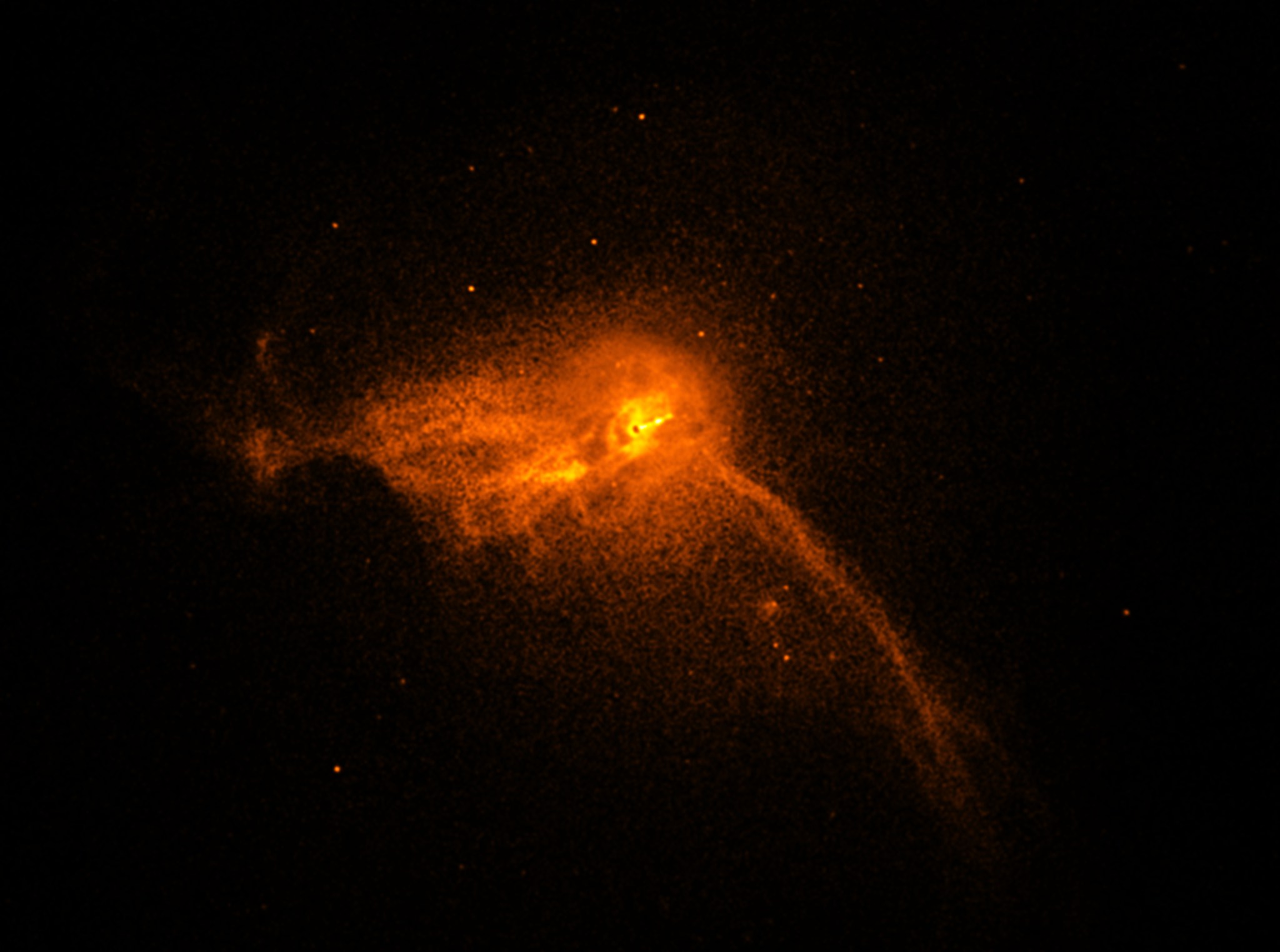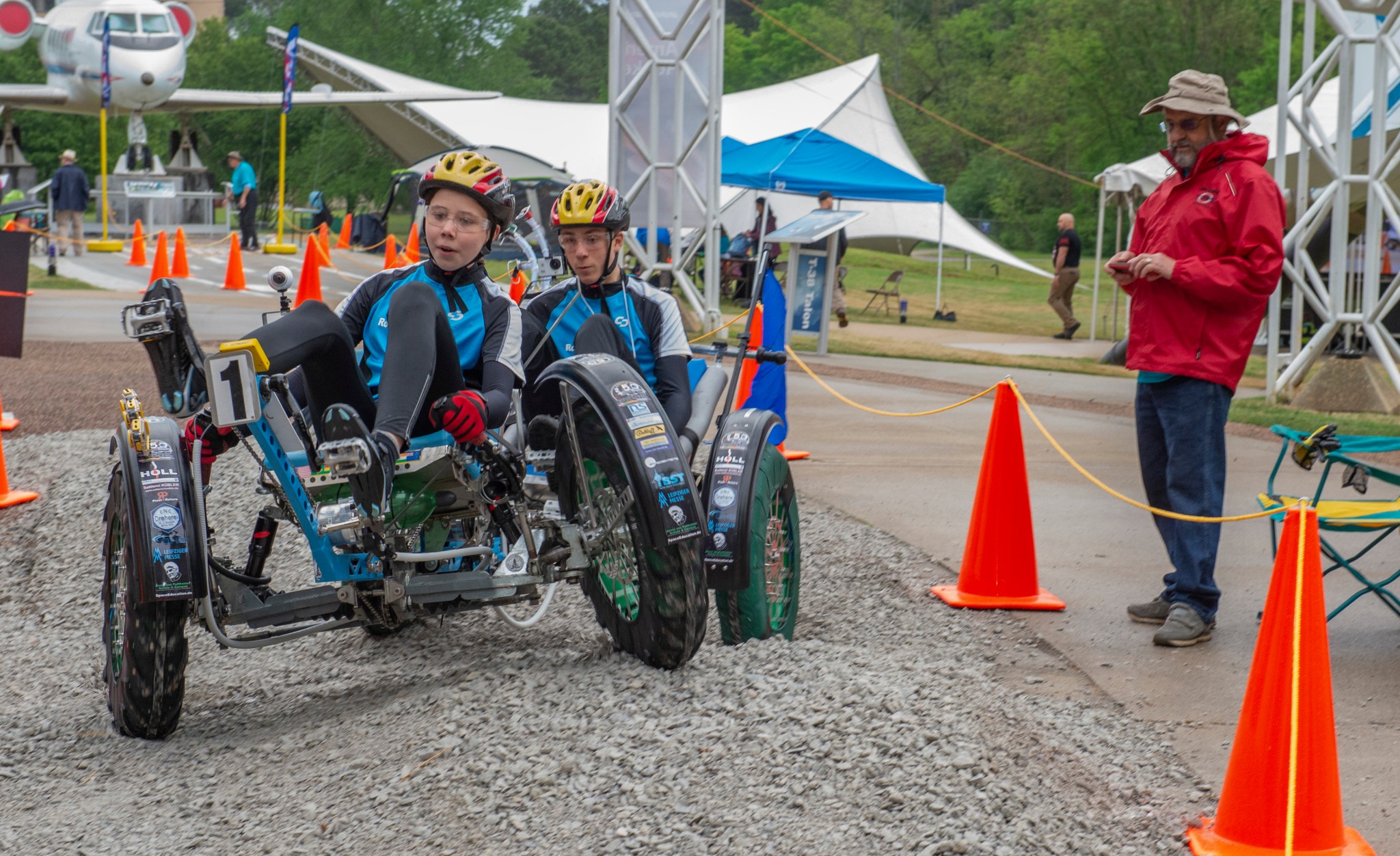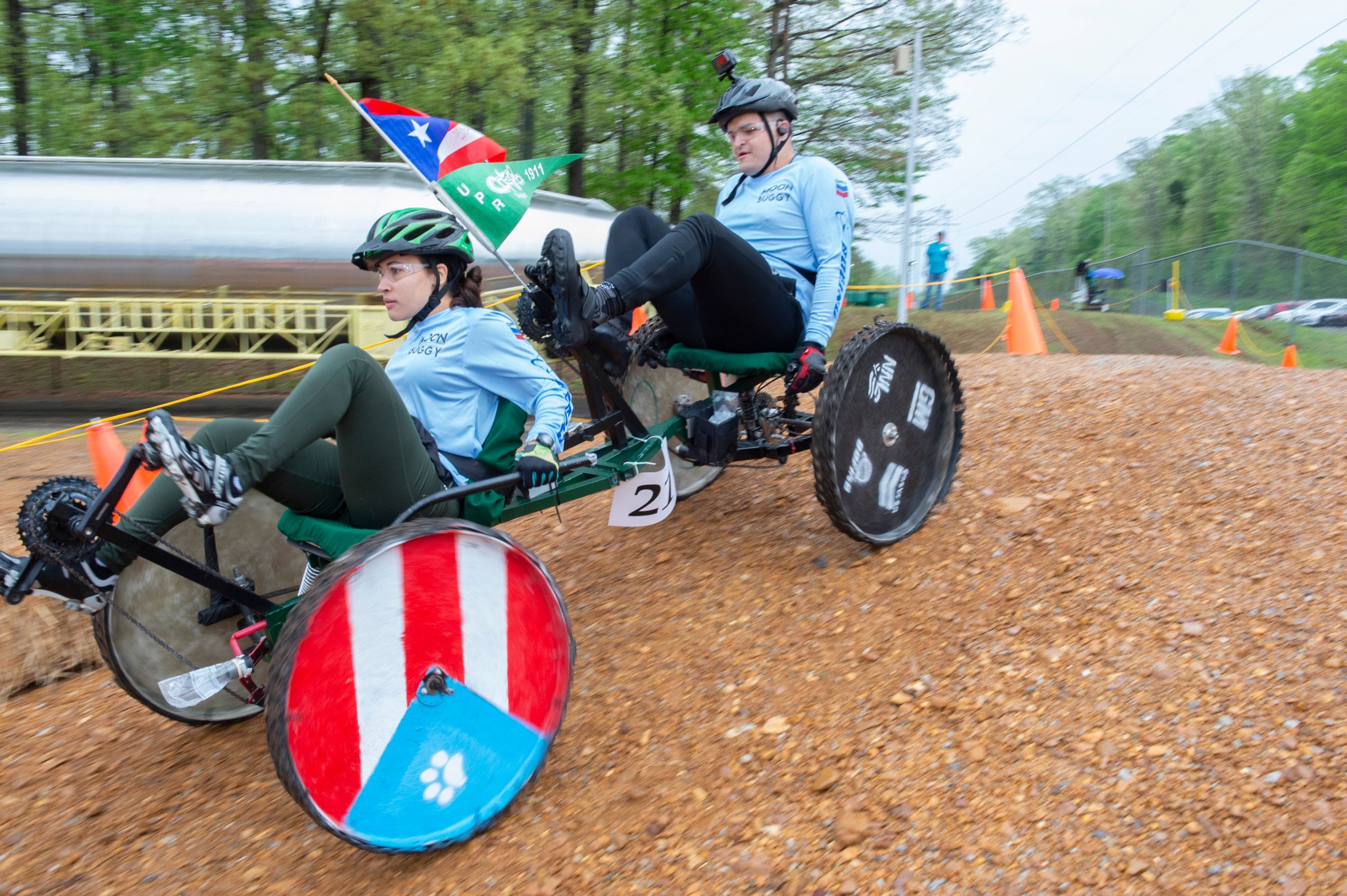In This Week’s Star
- Chandra Captures X-rays in Coordination with Event Horizon Telescope
- CLASP-2 Successfully Launches to Study the Sun
- FCC Commissioner Brandon Carr Visits Marshall
- NASA Astronaut Candidates Tour Marshall
- Technicians Join SLS Engine Section and Boat-tail with New Tool
- Technicians Use Innovative 3D-Printing Process for SLS Rocket Thermal Protection
- NASA Announces Winners of 25th Annual Rover Challenge
- Marshall Hosts Small Business Alliance Meeting on April 11
- Marshall Tech Talk Features SLS Manager Andy Schorr
- This Week in NASA History: 15th Anniversary of the Launch of Gravity Probe B – April 20, 2004
Chandra Captures X-rays in Coordination with Event Horizon Telescope
An international network of radio telescopes – together called the Event Horizon Telescope — has captured the first-ever image of a black hole and its shadow, and NASA’s Chandra X-ray Observatory, managed by NASA’s Marshall Space Flight Center, was more than a mere bystander.
The dark portrait shows the shadow of the supermassive black hole at the center of the galaxy Messier 87, or M87. Catching its shadow involved eight ground-based radio telescopes around the globe, operating together as if they were one telescope the size of Earth.
To complement the findings, astronomers used Chandra to observe the black hole at the same time as the Event Horizon Telescope in April 2017. By combining Chandra’s X-ray data with the new radio image, scientists can learn more about the giant black hole and its behavior.
“The past many months have seen two of the most ground-breaking observations of the century: the detection of gravitational waves and the direct imaging of a black hole,” said Martin Weisskopf, project scientist for Chandra. “We are proud that in both cases Chandra, with its unprecedented capability for X-ray observations, has played and will continue to play a vital role in the multi-wavelength campaigns to penetrate the astrophysics of these phenomena.”
While Chandra observations did not directly trace out the historic image, astronomers used Chandra to measure the X-ray brightness of the jet of high-energy particles around the black hole at M87. Chandra has a much larger field of view than the Event Horizon Telescope, so it can view the full length of the jet, which extends more than 1,000 light years from the center of the galaxy.
M87 is an elliptical galaxy in the Virgo galaxy cluster, about 60 million light years away from Earth. For years, scientists have known that a supermassive black hole weighing several billion times the mass of the Sun sits at the center of M87.
Surrounding the elliptical galaxy is a reservoir of multimillion-degree gas, which glows brightly in X-ray light. Chandra’s studies of this hot gas have given astronomers insight into the behavior and properties of the giant black hole. For example, astronomers have used Chandra data to discover ripples in the hot gas, which provide evidence for repeated outbursts from the black hole roughly every 6 million years or so.
The Event Horizon Telescope is an international collaboration whose support includes the National Science Foundation. Marshall manages the Chandra program for NASA’s Science Mission Directorate in Washington. The Smithsonian Astrophysical Observatory in Cambridge, Massachusetts, controls Chandra’s science and flight operations.
For more information about the Chandra’s M87 observations and coordination with the Event Horizon Telescope, including images and videos, visit here and here.
CLASP-2 Successfully Launches to Study the Sun
On April 11 at 11:51 a.m., an international cadre of scientists and engineers craned their necks skyward as a research rocket soared into blue skies over White Sands Missile Range in New Mexico.
CLASP-2, short for Chromospheric Layer Spectropolarimeter-2, is a suborbital sounding rocket experiment led by NASA’s Marshall Space Flight Center. The instrument is designed to look for hidden details in the chromosphere, a layer of the Sun’s atmosphere.
Using a technique called spectropolarimetry, CLASP-2 has made it possible to detect both linear and circular polarization in the ultraviolet light emitted by ionized magnesium atoms in the chromosphere–polarization signatures never before gathered at these ultraviolet wavelengths.
Encoded in these measurements is important information about the strength and direction of the Sun’s magnetic field, explained David McKenzie, CLASP-2 principal investigator at Marshall. Scientists will use the data collected to help unlock new clues about how energy travels up through the layers of solar atmosphere, and eventually out into space.
“Unraveling the complexity of the magnetic field in the solar chromosphere is a key challenge in astrophysics,” said McKenzie. “Understanding how the magnetic field works is vital to predicting powerful solar activity and protecting space and Earth technology from potential damage from geomagnetic storms.”
To accomplish their goal, a Black Brandt IX sounding rocket catapulted the instrument above Earth’s atmosphere. Reaching an apogee of 170 miles, CLASP-2 captured images and collected data for about five minutes before parachuting back to the desert, where it was recovered by helicopter.
Smaller, more affordable and faster to design and build than large-scale satellite missions, sounding rockets offer a way for the team to test their latest ideas and instruments and achieve rapid science results.
“Not only are Marshall scientists expanding knowledge of our own star, they are doing so in a way that aligns with the center’s commitment to mission, people and partnerships,” said Rae Ann Meyer, recently named deputy manager of Marshall’s Science and Technology Office, who attended the launch. “This international team—partnering with the Navy, Army, other centers and observing programs—negotiated the weather, the Sun’s activity and mission goals like a tight-knit team.”
Over the next couple months, CLASP-2 team members around the world will use advanced computer modeling to interpret the data and report their findings.
“We will release our data to the public as soon as we have finished calibration. We want our data to be free and accessible to all, as this greatly improves that scientific impact of our efforts,” said Laurel Rachmeler, CLASP-2 project scientist. “We did not just launch this rocket for us, we do it for the advancement of science and human knowledge.”
CLASP-2 is a follow-on mission to the Chromospheric Lyman-Alpha Spectro-Polarimeter, which gave us the first-ever polarization measurements of ultraviolet light emitted from the Sun’s chromosphere. Previous polarization measurements were restricted to visible and infrared light emitted from other emission lines and did not include circular polarization.
Truly a global mission, CLASP-2 is based on pioneering theoretical research by Javier Trujillo Bueno and his research group at the Instituto de Astrofísica de Canarias in Santa Cruz de Tenerife, Spain. Bueno, CLASP-2’s Spanish principal investigator, attended the launch along with Japanese principal investigator Ryohko Ishikawa and other science team members from the National Astronomical Observatory of Japan. The Japanese team provided and calibrated the optical system for the telescope.
CLASP-2 is supported through NASA’s Sounding Rocket Program at the agency’s Wallops Flight Facility in Virginia. NASA’s Heliophysics Division manages the sounding rocket program.
FCC Commissioner Brandon Carr Visits Marshall
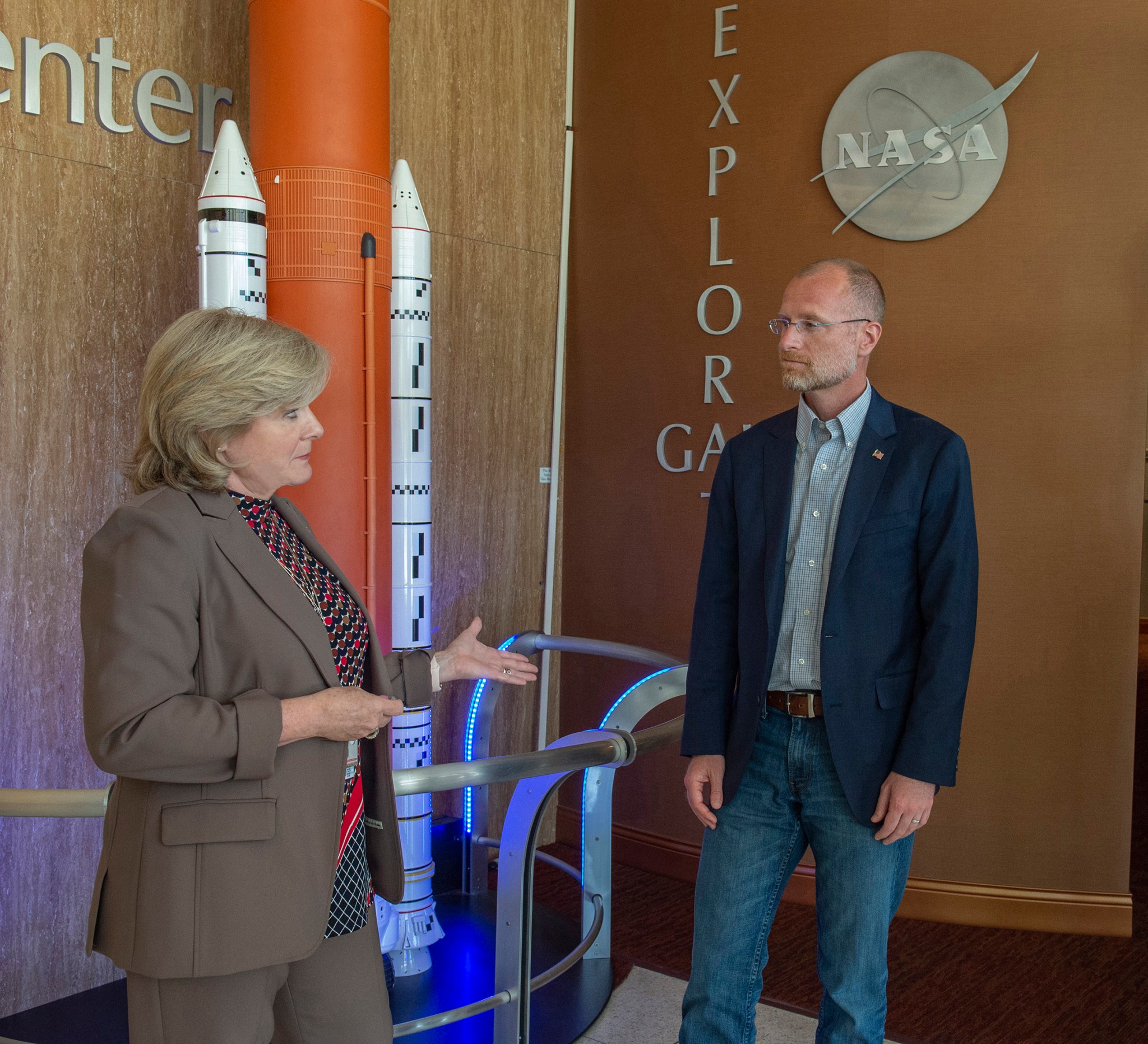
FCC Commissioner Brandon Carr meets with NASA’s Marshall Space Flight Center Director Jody Singer after a tour of the center on April 16. He toured the Payload Operations Integration Center, as well as Marshall’s Geostationary Operational Environmental Satellites antennas that receive information from satellites 25,000 miles above the surface of the earth that were installed last year. Carr was nominated, confirmed and sworn in to serve as a commissioner in August 2017. (NASA/MSFC/Emmett Givens)
NASA Astronaut Candidates Tour Marshall
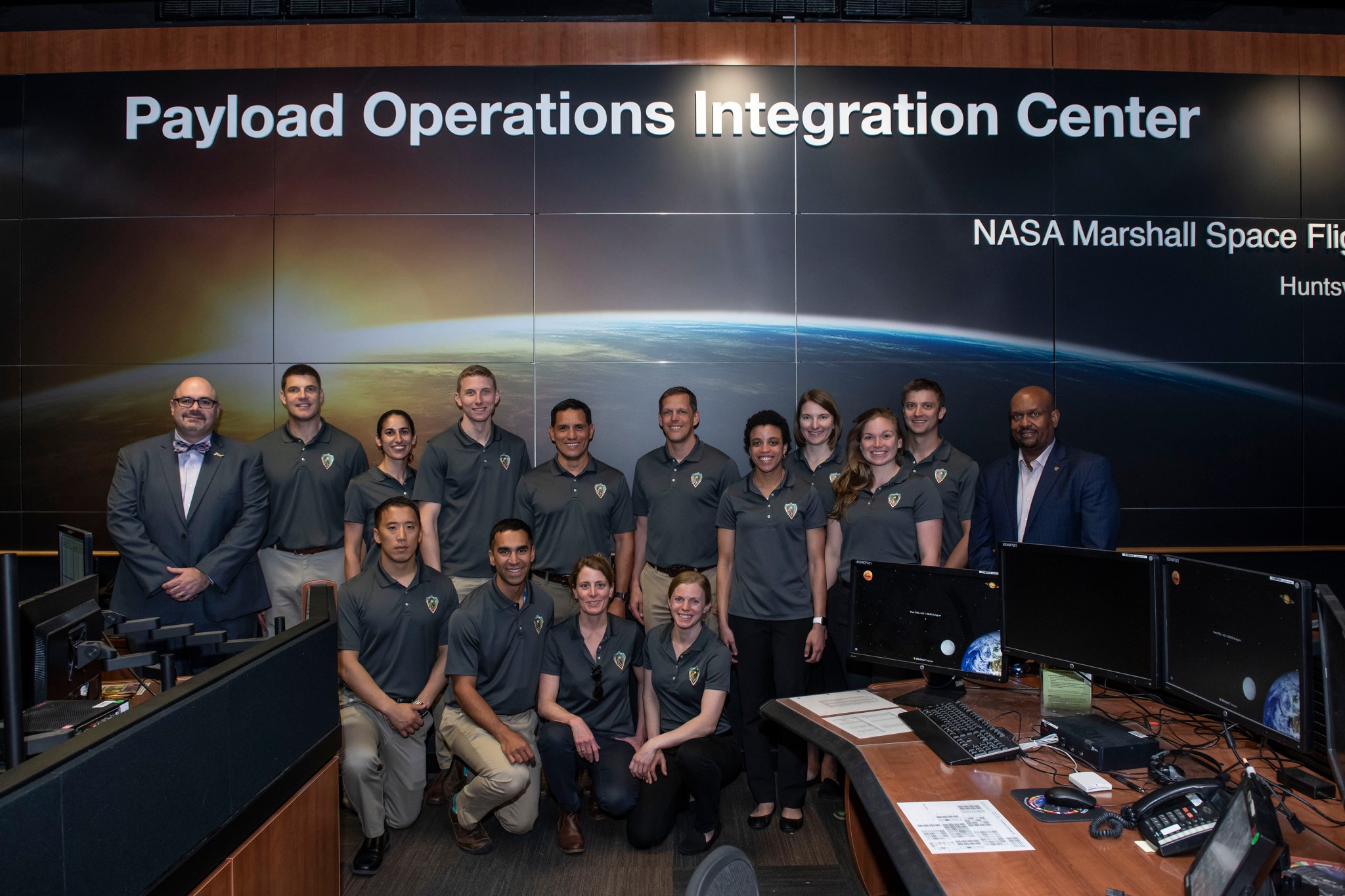
NASA’s newest astronaut candidates from the class of 2017 visit the Payload Operations Integration Center at Marshall Space Flight Center on April 15. Bobby Watkins, far right, director of the Human Exploration Development and Operations Office, and Joseph Pelfrey, far left, deputy director of HEDO, spoke to the candidates about the operation center’s 24/7, 365 days-a-year role supporting science on the International Space Station. They also discussed the history of human spaceflight at Marshall and Marshall’s ongoing roles in other related projects, including Commercial Crew and the Gateway. The candidates also visited the Space Launch System liquid hydrogen test tank at Test Stand 4693 and met with Center Director Jody Singer. (NASA/Fred Deaton)
Technicians Join SLS Engine Section and Boat-tail with New Tool
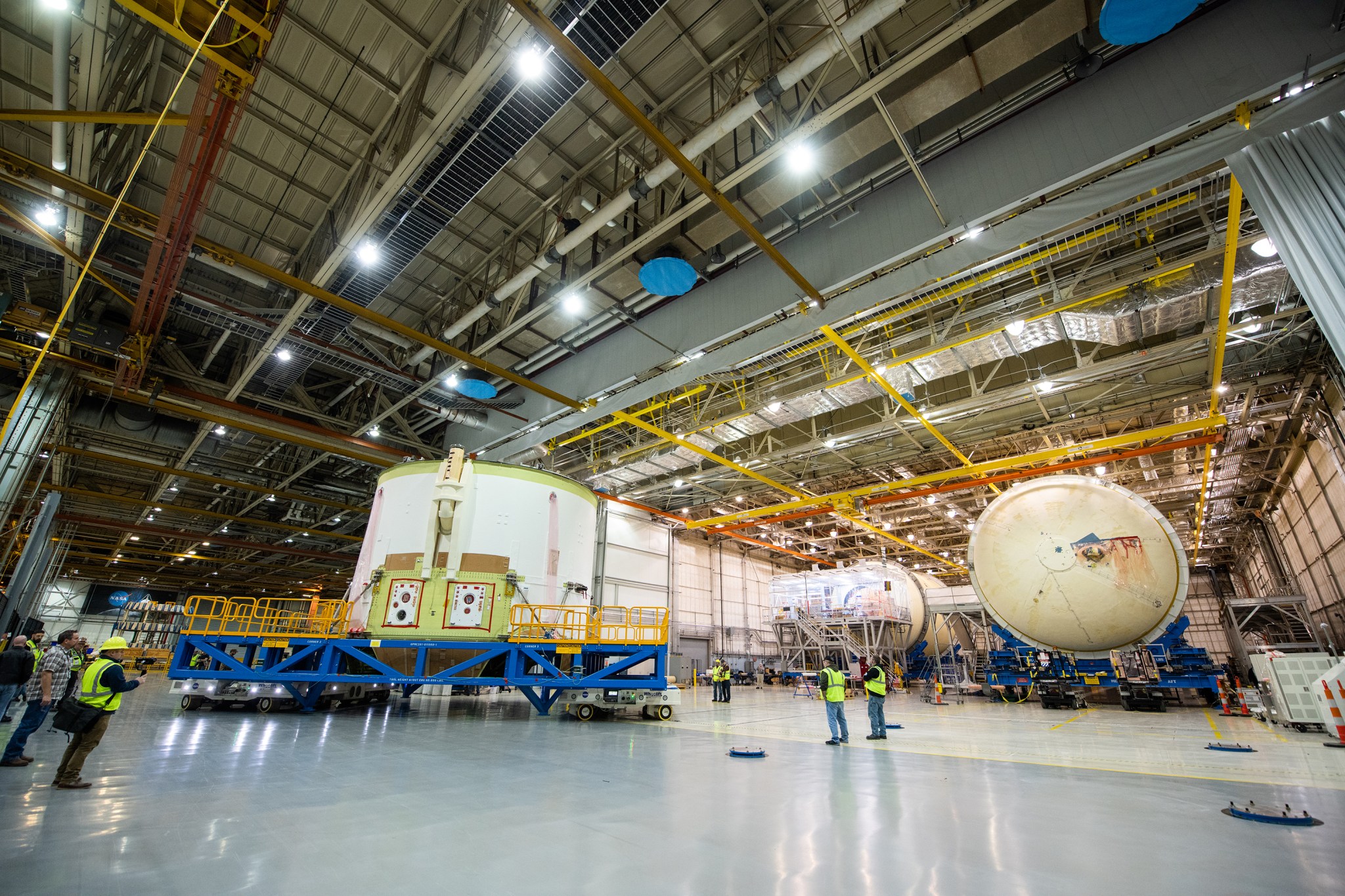
The boat-tail structure, a fairing-like cover designed to protect the bottom end of the core stage and the RS-25 engines, has been joined to one of the most complicated and intricate parts of NASA’s Space Launch System — the engine section. The engine section comprises the lowest portion of the massive core stage of the deep space rocket. It houses four RS-25 engines that will produce 2 million pounds of thrust to send the rocket and NASA’s Orion spacecraft on lunar missions. Technicians moved the engine section and boat-tail for final assembly to a climate-controlled area of NASA’s Michoud Assembly Facility. Engineers will use the new tool and an internal access kit to finish assembly. The tool, seen here in the blue frame around the bottom of the engine section, allows more people to work on engine section tasks at the same time, accelerating production and reducing integration and assembly time. This tool, along with other production and processing improvements, will help enable the core stage to be completed this year. The liquid oxygen tank structural test article as well as the liquid hydrogen tank flight hardware for the first mission of SLS are located just behind the engine section. (NASA/Jude Guidry)
Technicians Use Innovative 3D-Printing Process for SLS Rocket Thermal Protection
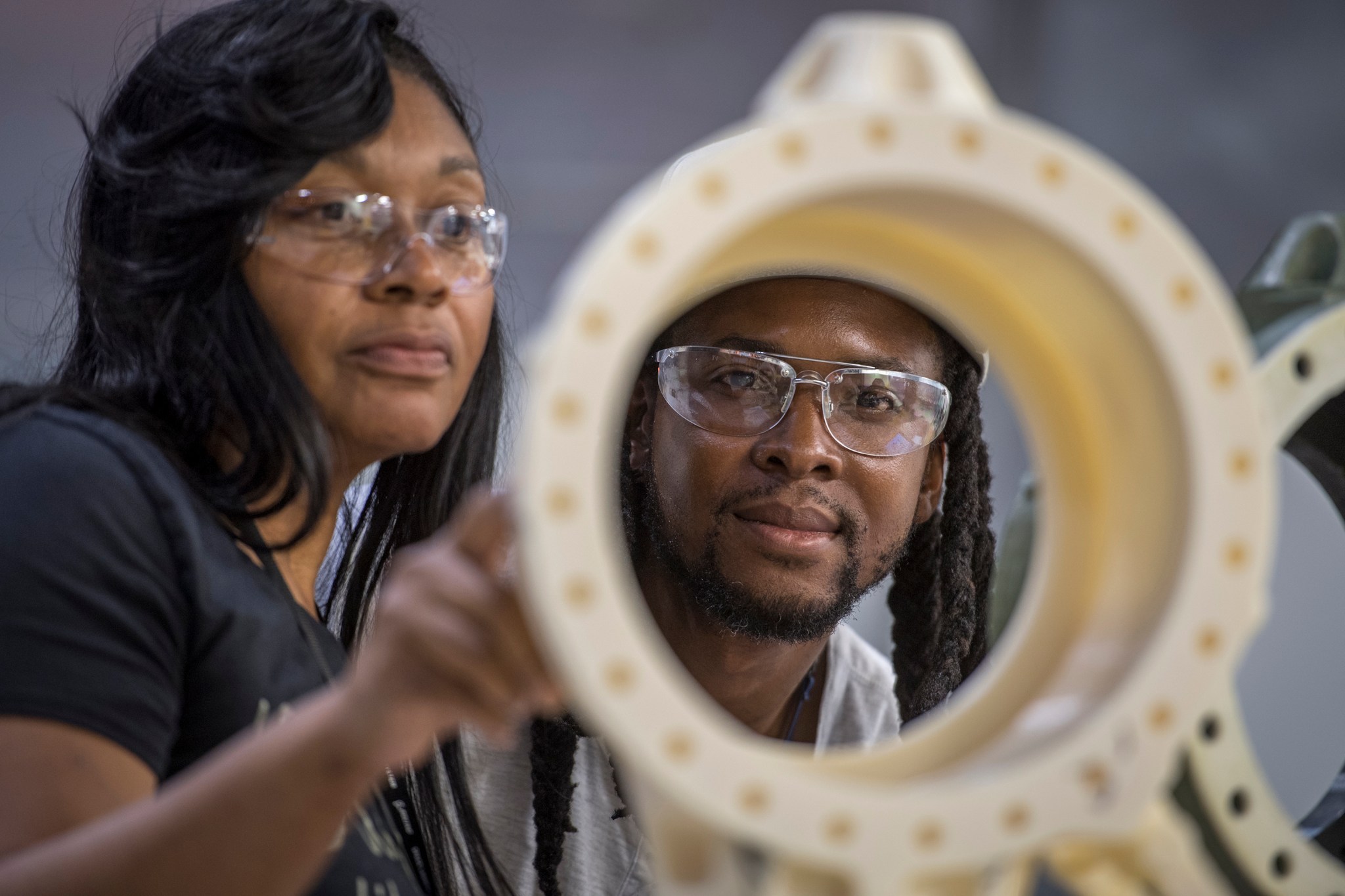
Technicians and engineers have qualified 3D-printing to aid in the application of the thermal protection system to the smaller, more intricate parts of NASA’s Space Launch System rocket. Spray-on foam or traditional insulation is applied to both large and small components of SLS. It protects the rocket from heat during launch and keeps the propellant within the large tanks cold. However, small hardware or cramped areas such as the internal ducts of the engine section require technicians to either manually spray the foam on or apply a foam casting using, in some cases, a 3D-printed mold. During the process, the foam, which is mixed and poured into the mold, expands to perfectly fit the part. This decreases overall processing time by reducing the need for complex and tedious post-process trimming. NASA and Boeing engineers performed extensive development and qualification pour foam testing early in the program. Using this data, the team developed a refined process that reduced the amount of time required to certify individual 3D-printed molds and allowed the team to spend more time focusing on the critical requirements that must be met for each flight foam application. This streamlined the process, from 3D-printing to pour application, and allowed for quicker processing times. (Boeing)
NASA Announces Winners of 25th Annual Rover Challenge
NASA has announced the winners of the 2019 Human Exploration Rover Challenge, held April 12-13 at the U.S. Space & Rocket Center in Huntsville, Alabama.
The International Space Education Institute of Leipzig, Germany, won first place in the high school division with 91 points; and the University of Puerto Rico Mayagüez – Team 1 won the college/university division with 101 points. Teams were awarded points based on the successful navigation of obstacles and completion of tasks.
The competition, hosted by NASA’s Marshall Space Flight Center and held at the U.S. Space & Rocket Center, challenges high school and college teams to design, build and test human-powered roving vehicles inspired by the Apollo lunar missions and future exploration missions to the Moon, Mars and beyond. This year’s competition marked 25 years since the inaugural event, a milestone that fittingly coincided with the NASA’s Apollo 50th anniversary.
“Celebrating a quarter-century of Rover Challenge alongside the agency’s commemoration of Apollo has made this a very special year for all of us,” said Bob Musgrove, Acting Manager of the Office of STEM Engagement at Marshall. “The creativity, skill and resourcefulness demonstrated each year on the rover course are the very traits that paved our path to the Moon in 1969, and the ones that will continue to carry NASA forward to the Moon again in 2024. We are so proud to congratulate this year’s winners, and every team that competed.”
NASA astronaut and two-time spaceflight veteran Sunita “Suni” Williams attended the second day of the event, interacting with teams and participating in the day’s activities.
Rover Challenge continues the agency’s mission of providing valuable learning opportunities to students who, someday, may be responsible for planning future space missions, including crewed missions to other worlds. After constructing their own rovers, teams attempt to traverse a nearly three-quarter-mile course with grueling obstacles that simulate terrain found on Mars, as well as other planets, moons and asteroids throughout the solar system. In addition, they have to complete tasks, such as sample collection and instrument deployment.
Teams had a six-minute window to navigate the course, gathering points and trying to complete the 14 obstacles. This year’s competition also offered a Technology Challenge Award, which tasked teams to construct their own wheels — with the exception of the central hub – rather than purchase them commercially.
Nearly 100 teams took part in the competition, hailing from 23 states, the District of Columbia and Puerto Rico, as well as a record number of countries, including Bangladesh, Bolivia, Brazil, the Dominican Republic, Egypt, Ethiopia, Germany, India, Mexico, Morocco and Peru.
The competition, managed by Marshall’s Office of STEM Engagement, is one of many NASA initiatives to encourage students to study the STEM fields of science, technology, engineering and mathematics, and to inspire the next generation of explorers.
Replays of the competition are available on a variety of streaming platforms, including Facebook, Periscope and Ustream.
The complete list of award winners is below.
High School Division
- First Place: International Space Education Institute (Leipzig, Germany), 91 points
- Second Place: Saint Thomas Academy (Mendota Heights, Minnesota), 91 points
- Third Place: University Gardens High School (San Juan, Puerto Rico), 86 points
College/University Division
- First Place: University of Puerto Rico Mayagüez- Team 1, (Mayagüez, Puerto Rico), 101 points
- Second Place: Rhode Island School of Design (Providence, Rhode Island), 95 points
- Third Place: University of Puerto Rico Humacao – Team 2, (Humacao, Puerto Rico), 88 points
AIAA Neil Armstrong Best Design Award
- High School Division: Parish Episcopal School – Team 2 (Dallas, Texas)
- College/University Division: KIET Group of Institutions (Ghaziabad, Uttar Pradesh, India)
Technology Challenge Award
- Saint Thomas Academy (Mendota Heights, Minnesota)
Drive Train Technology Challenge
- Blue Ridge High School (Pinetop, Arizona)
- University of Central Missouri – Team 1 (Warrensburg, Missouri)
Featherweight Award
- High School Division: Saint Thomas Academy (Mendota Heights, Minnesota)
- College/University Division: Rhode Island School of Design (Providence, Rhode Island)
AIAA Telemetry/Electronics Award
- Universidad Nacional de Ingenieria (Peru)
Crash and Burn Award
- Mt. Juliet High School – Team 1 (Mt. Juliet, Tennessee)
Frank Joe Sexton Memorial Pit Crew Award
- High School Division: Bearden High School (Knoxville, Tennessee)
- College/University Division: Mukesh Patel School of Technology Management and Engineering (Vile Parle, Mumbai, India)
Team Spirit Award
- Parish Episcopal School – Team 1 (Dallas, Texas)
Rookie of the Year Award
- Saint Thomas Academy (Mendota Heights, Minnesota)
Jesco von Puttkamer International Team Award
- High School Division: International Space Education Institute (Leipzig, Germany)*
*ISEI donated their award to team Centro de Tecnologia Em Educação (Petrópolis, Rio de Janeiro, Brazil) - College/University Division: Technólogico de Monterrey (Mexico)
AIAA Best Report Award
- High School Division: Parish Episcopal School – Team 2 (Dallas, Texas)
- College/University Division: University of Memphis (Tennessee)
System Safety Challenge Award
- High School Division: International Space Education Institute (Leipzig, Germany)
- College/University Division: Mukesh Patel School of Technology Management and Engineering (Vile Parle, Mumbai, India)
Most Improved Award
- High School Division: International Space Education Institute (Leipzig, Germany)
- College/University Division: Owensboro Community and Technical College – Team 1 (Owensboro, Kentucky)
STEM Engagement Award
- High School Division: Saint Thomas Academy (Mendota Heights, Minnesota)
- College/University Division: Lovely Professional University (Phagwara, Punjab, India)
Legacy Award
- University of Alabama in Huntsville
- University of Puerto Rico Humacao
Marshall Hosts Small Business Alliance Meeting on April 11
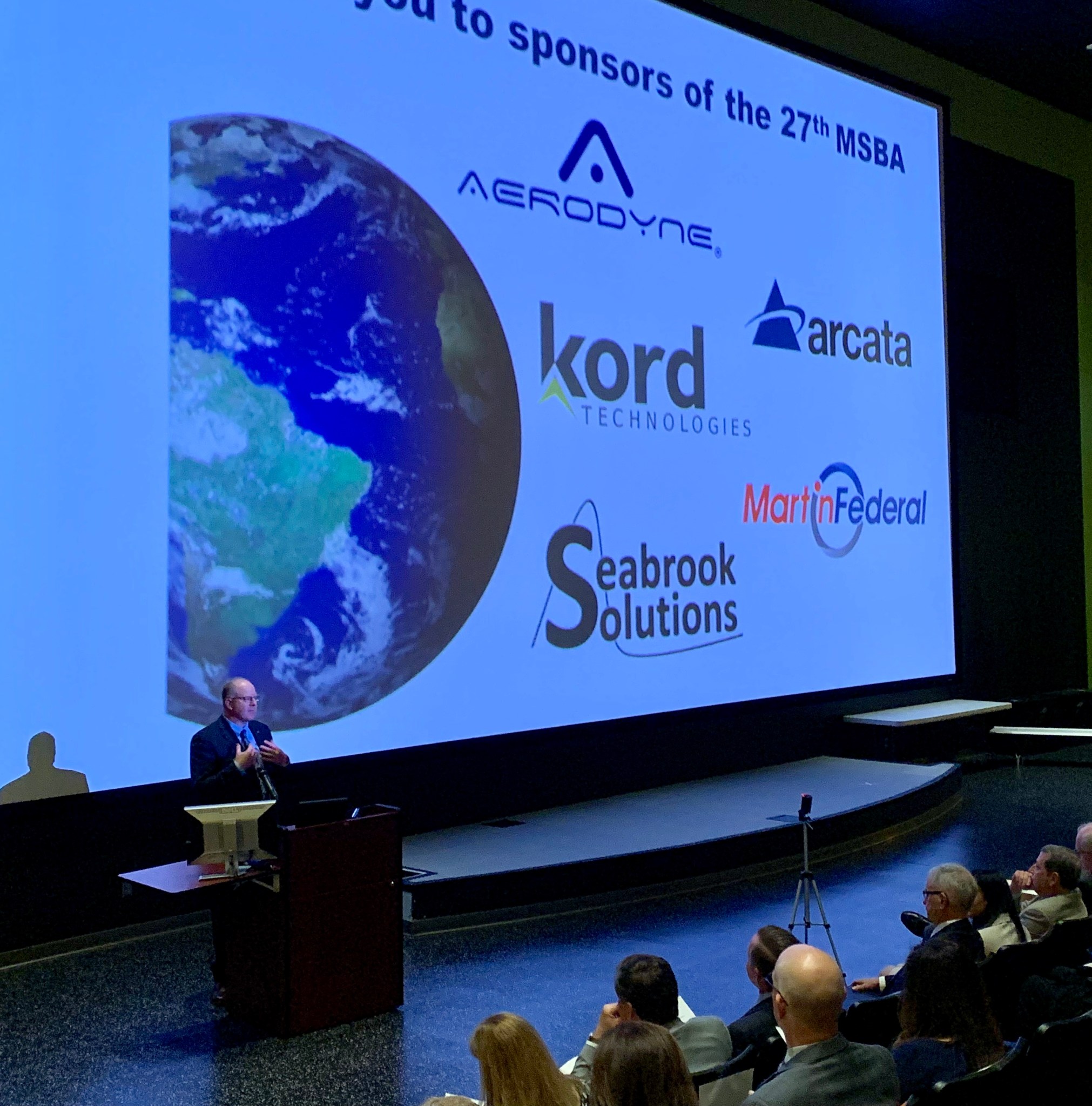
Jason Detko, director of NASA Marshall Space Flight Center’s Office of Procurement, engages participants during his opening remarks at this year’s Small Business Alliance Meeting held at the Davidson Center for Space Exploration on April 11. Marshall’s Small Business Office shared the latest contract opportunities with representatives of large and small businesses, NASA prime contractors and subcontractors. For more than a decade, the Marshall Small Business Alliance has aided small businesses in pursuit of NASA procurement and subcontracting opportunities. (NASA/Morgan Hopper)
Marshall Tech Talk Features SLS Manager Andy Schorr
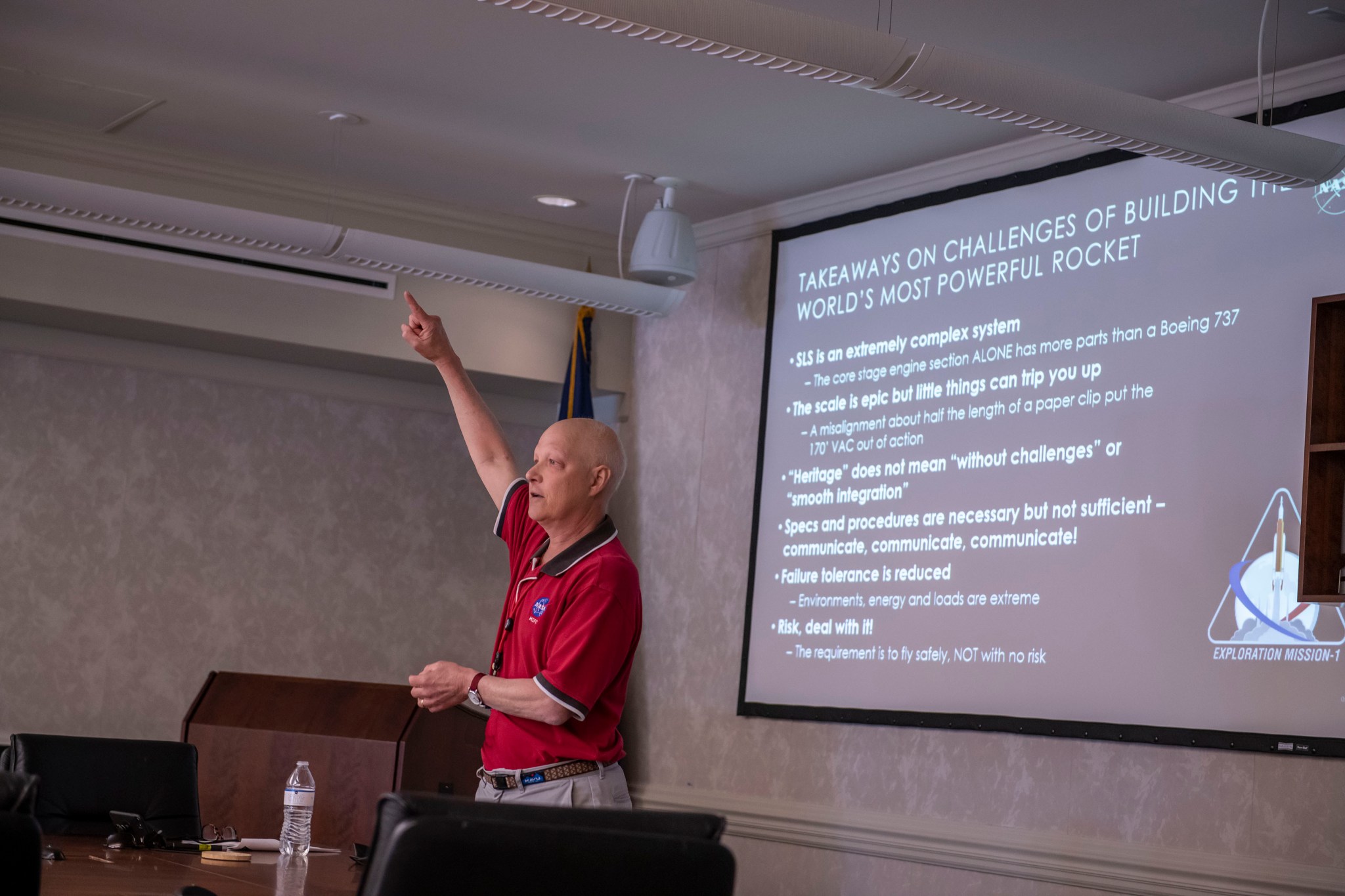
Andy Schorr, deputy manager for the Spacecraft Payload Integration and Evolution Office for NASA’s Space Launch System, presents an in-depth look at the progress on the deep space rocket at the monthly Marshall Tech Talk Series on April 17. He discussed the unique capabilities and challenges that come from building a rocket as large and powerful as SLS. Schorr said such challenges reinforce how engineers and technicians should remain adaptive throughout this process. He also stressed how best practices from the agency’s past missions, along with real-time evaluations for the current mission, will help the SLS team remain on target to return American astronauts to the Moon by 2024. Marshall Tech Talks, held the second Thursday of each month, feature innovating topics of interest to the Marshall Space Flight Center community. (NASA/Fred Deaton)
This Week in NASA History: 15th Anniversary of the Launch of Gravity Probe B – April 20, 2004
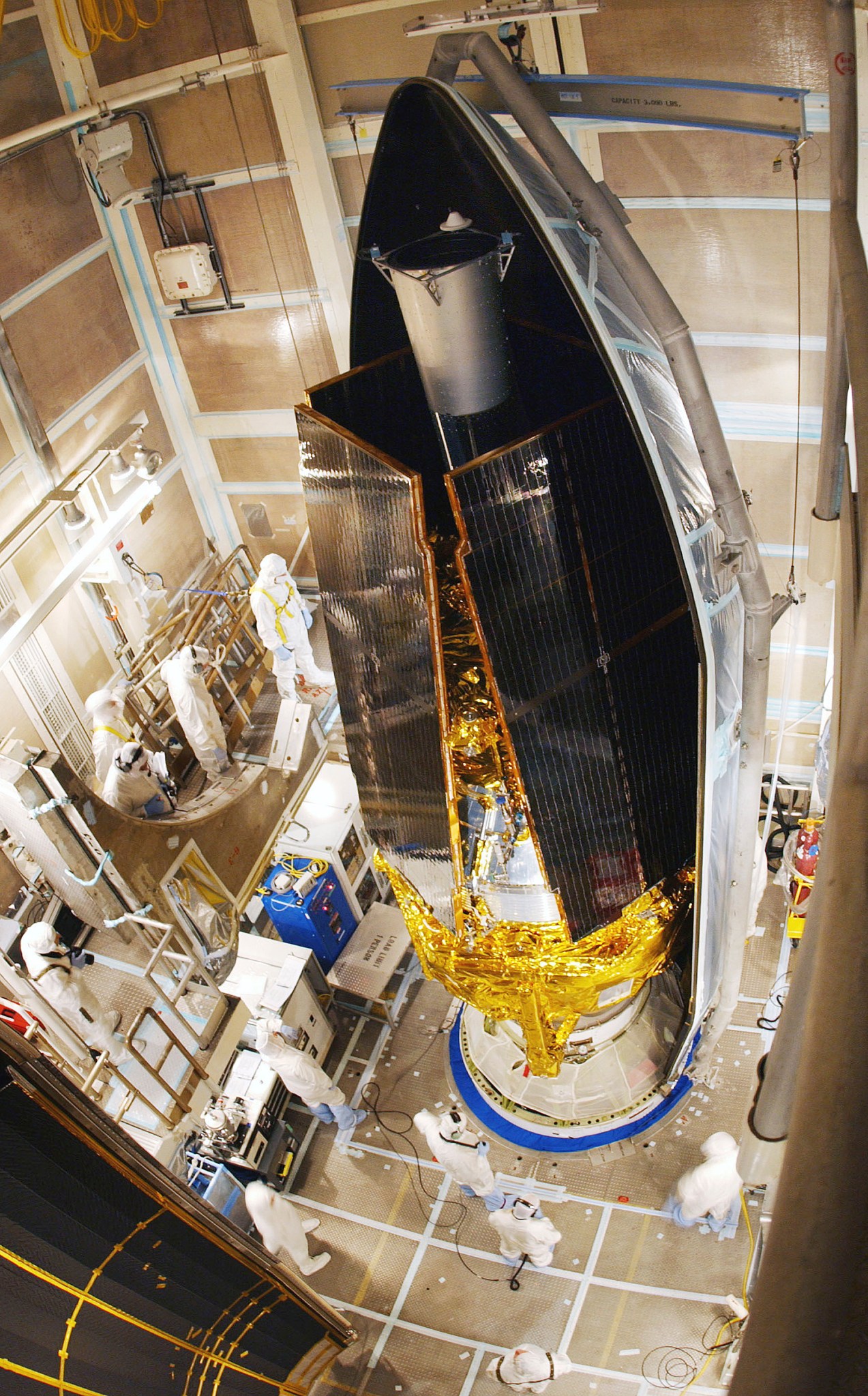
This week in 2004, Gravity Probe B was launched from Vandenburg Air Force Base atop a Delta II launch vehicle. Developed by Stanford University and Lockheed Martin, Gravity Probe B was an experiment designed to test two predictions of Albert Einstein’s general theory of relativity. NASA’s Marshall Space Flight Center managed the mission for NASA. Here, the space vehicle is encapsulated atop the Delta II launch vehicle in preparation for launch. The NASA History Program is responsible for generating, disseminating and preserving NASA’s remarkable history and providing a comprehensive understanding of the institutional, cultural, social, political, economic, technological and scientific aspects of NASA’s activities in aeronautics and space. For more pictures like this one and to connect to NASA’s history, visit the Marshall History Program’s webpage. (NASA)





























